As I began to love myself
As I began to love myself
As I began to love myself
As I began to love myself
As I began to love myself
As I began to love myself
As I began to love myself
As I began to love myself
As I began to love myself
We no longer need to fear arguments,
Posted in Uncategorized | Leave a Comment »
Last night I dreamt I was looking into the face of a very beautiful woman (I can hear you sighing and rolling your eyes, but I did!). I felt as if I was falling into her beauty, becoming obsessed with it. She looked at me and simply acknowledged my gaze, without much concern. In the way that deities do. (The proclivities of humanity are of little concern to them, given that our behaviours and obsessions are shaped by our own mortality). Her simple acknowledgment caused me to step backwards. Instead of being obsessed with my gaze and her beauty, I registered her entire being.

Perhaps the deity was Lakshmi?
What I saw upon stepping back was a rich array of artefacts, archetypal images and growth that seemed to surround her. Concentric circles of glowing green, and an abundance of otherness that I can’t recall. But it left me with two lasting impressions:
- She seemed to be defined by a word – abundance. In excess of the expression of beauty that my own gaze locked onto. I thought of child brith, and the manner in which a woman exceeds her own apparent totality, by producing new life. This is only one form of the deity’s abundance, but one that stayed in my mind.
- The reductive nature of the male gaze. By focussing only on the deity’s beauty I was missing the extraordinary array of abundance that surrounded her. An abundance that was as much a part of her, as was her own bodily attributes. It made me think of how a man’s sexual obsessions with a woman reduces her to the content of the male gaze, thereby ignoring the rich growth that exists in excess of the body.
This is not an attempt to reduce women or men to some type of natural order, or stereotypes. It is simply the recounting of a dream. My own unconscious manifestation of the effect of the reductionism of the male gaze. I thought is was interesting enough to share.
Posted in Uncategorized | Leave a Comment »
Recently I led an interdisciplinary research team investigating the potential of ‘noise transformation’ as a soundscape design method for improving the life of those living along motorways. The research was funded by the toll-way company, Transurban. Our team worked directly with their sustainability department, who are responsible for funding art and design programs, innovative research ideas and sustainable energy projects.
Some peers, in private correspondence, have raised their concerns about the instrumentalisation of art that such projects might represent. I find this to be a limited view, inso far as it contains art within a narrow perception of having to be obtuse, radical or provocative. My attitude is that art exists with our without artists, and the existence of manifested art, and as such its potential applications and realisations are unlimited. Art cannot be contained or controlled – not for long anyway – and as such we shouldn’t be afraid to apply art in various scenarios.
In this project, artistic processes are applied as a means to come up with real world solutions. In this case, if people are forced to live with motorway noise can we apply modern technologies to reduce the annoyance and anxiety created by these noisy soundscapes to improve quality of life? It builds on a long history of composers interested in urban sounds and composition, including Russolo, Varese, Cage, Westerkamp and Oliverios.
The full report can be accessed here: https://www.transurban.com/sustainability/innovation-grants/rmit-motorway-noise-project
An article I wrote on the potential of turning traffic noise into music can be accessed here: https://blog.transurban.com/news/the-sound-of-music.
Posted in art, music | Tagged art, music | Leave a Comment »
I have just returned from the Sonologia conference in Sao Paulo, Brazil. Sonology is the term given to Latin American Sound Studies by the research group, who facilitated the conference. The range of papers was fascinating, with a particularly strong compliment of ethnographic studies and cultural and sociological reflections on the role and implication of sounds in everyday life.
It was interesting to note there was little discussion about the placement of sounds in public spaces, a theme of interest in a concurrent conference at Leiden University. Mine and one other by Colin Ripley, were the only two. Most soundscape papers reflected on existing sounds, and the capacity of ethnography to reveal community relationships with these sounds. It now occurs to me why this might be the case, after having spent a week in the megalopolis of Sao Paulo.
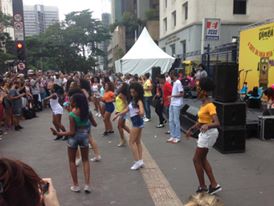
Samba dancing in Avenue Paulista
There is SO much sound in this city, why would you want to introduce more? The streets are alive with activity. In Avenue Paulista, in one day, I encountered music, protests, football and political chants, traffic, fire crackers and car horns. The city is extraordinarily vibrant and eventful. Alternatively, my work, which intervenes in everyday life with sound installations, has developed in the context of Australian suburban quietude, where I would argue we encounter cultural alienation manifesting as isolation.
After my talk some discussion occurred around the desirability of adding sounds to the urban environment. My feeling was (perhaps correctly, or not) that my Brazilian colleagues were less convinced by the idea of adding sounds, in distinction to understanding relationships with those sounds that already exist. Upon reflection, it occurred to me if addition is a worthy approach in a quite country like Australia, then perhaps subtraction is the favoured approach for such a noise-filled city as Sao Paulo.
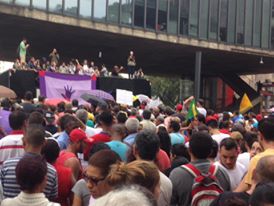
politcal protests in Avenue Paulista
And I don’t mean noise in the negative sense. I mean it in the sense of ceaseless invigoration, just as I mean quiteude as a type of cultural retraction. It left me with the sense that each city has its own particular challenges, thus further emphasising the importance of site-specific sound art practices.
Posted in Uncategorized | Leave a Comment »
Salome Voegelin – artist and writer engaged in listening as a socio-political practice of sound – interviewed me about my listening practice, and the ‘sonic rupture’ concept that I outlined in my book, Sonic Rupture: a practicer-led approach to urban soundscape design (Bloomsbury 2016).
The interview includes sound files and images from recent sound works, and references to a number of projects I am presently involved in:
Posted in Uncategorized | Leave a Comment »
I recently completed a tour of N-E America, the U.K. and Europe investigating sound installations. During my trip I discovered the Klankenbos Sound Forest in North Belgium (near the town of Neerpelt). I was asked to write a blog about my experiences. There are a number of audio recordings and images, as well as text.
http://www.klankatlas.eu/blog/dreaming-of-urban-sound-parks/
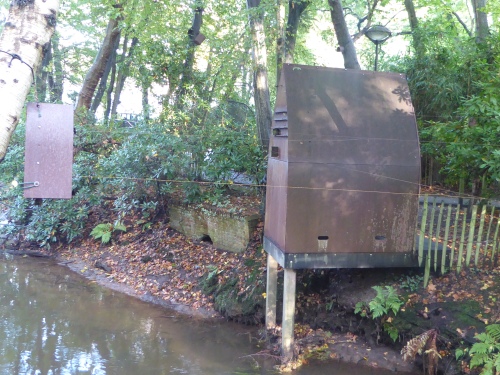
Houses of Sound (installation by Pierre Berthet)
Posted in art, soundscape | Leave a Comment »
I was a participating sound artist at the May 2015 Aural Lighthouses symposium in Santorini, Greece. As the brochure explains:
Curated by Ileana Drinovan-Nomikos, the event hosts artists and scholars from around the world including Greece, United States, India,United Kingdom, Australia, Germany and Italy. Sound artists and atmospheric scientists are brought together to evoke the emotional, affective and visceral responses of sound and frequency, and their effect beyond what scientifically manifests in graphs and images. The symposium explores human aural performance and how we make and create disaster sounds to seem natural and to fade into a perceived inaudibility. The works further explore the oscillation between apprehensive, stressed, distressed and relaxed listening, and so the difference between dread and the beauty of disaster listening.
My contribution was a four-channel immersive sound work, constructed from sonic materials that were part of my 2012 City of Melbourne public art work, Revoicing the Striated Soundscape. Unfortunately I couldn’t attend the conference but I was lucky enough to receive this feedback from the symposium co-coordinator, Ljubi Matic.
Rupture was played publicly starting from Tuesday May 19th, 2015 through Saturday May 23rd, 2015, every day for at least 4 afternoon and early evening hours. A separate room, approximately 4×4 meters large, was dedicated to the piece. Santozeum is a conglomerate of rooms of different sizes on several floors, so the audience could ramble around the space walking in and out during the pieces and taking in different sound events at their leisure. In the room where Rupture was listened to, there were 4 paintings on the walls, copies of the wall paintings of Akrotiri (an ancient site on Santorini). The speakers were located on the ground, in the 4 corners of the room. The audience was not seated (as I think you had originally suggested) because we thought that chairs would make the space too cramped. However, some listeners felt inclined to sit down while listening, on the ground and next to the speakers, and then rotate their position during their listening session. This rotation could and did happen quite quickly as the speakers were not too far from each other. The room, smaller than what is a typical gallery space, thus, I think, brought a special sensitivity to auditors’ 4-way movements. Those among the listeners who did not have the chance to read the info found in the brochure had not been informed about the type and provenance of the sounds you had created and used for the installation. Upon learning that, some came for the second time. An audience member told me he felt listening to Rupture transported him above the ground, to a flight of sorts, that is, flights of different kinds, some more or less comfortable, others evoking situations of fleeing and mobilization for war. Another one compared the listening experience to a “slow-motion of gigantic waves” with “abrupt abysses of silence (ruptures?) gaping from the oceanic expanse.” A third one was struck by the “compulsiveness” she sensed in the sounds of machinic origins as well as in her urge to stay put in the room and listen to them. The presence of ancient human and animal figures on the wall paintings gave a special twist to the experience at those moments where your composition brought breaths, sighs and strange (gutural?) sounds to the fore. It almost felt like anthropomorphic auricular traces were being uncovered from the strata of our machinic past, or like some kind of otherworldly communication was under way. Santorini, after all, is all about multifarious geological layers. Must be same for Melbourne and thank you for making us become aware of that.
I was also sent some photographs of the exhibition. Fascinating to consider Melbourne’s laneway sounds finding a home in the island of Santorini! 
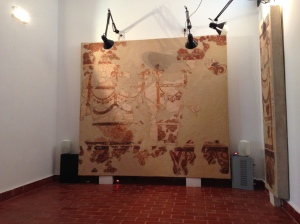

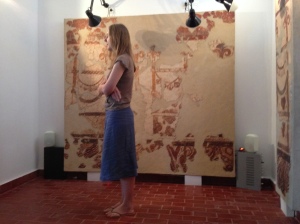
Posted in art, hiddensounds, music | Tagged installation, Sound Art, soundscape | Leave a Comment »
What is the sound of heavy industry, machinery and metal? Has it a detectable “atmosphere”, a taste, a sensuality? Urban noise is often loathed, and there is good reason for this considering its ubiquity, and dominating effects. And yet, inside noise, there is something tantalizingly alive. I think of urban noise as in its infant phase; a neglected child yet to find its true potential. Or a formless material without a maker to provide it with diverse expressions. Luigi Russolo, John Cage, Christina Kubisch and Max Neuhaus are four well-known composers/artists who brought to urban sound a musical sensibility; that is, treating urban noise with a musician’s respect.

Note the four speakers on the two containers. On the right container you can see one of the transducers in the center that was used to vibrate the container. Lengths of neon can be seen on both containers.
From the 22nd-24th January 2015, a team of artists including Fiona Hillary, Shanti Sumartojo, Eliot Palmer and myself were invited to produce a three-day atmosphere as part of Dagmara Gieysztor’s 3 month artist residency on the Maribyrnong River in Footscray. The shipping containers were located adjacent to a heavy freight rail bridge, which crossed the river to reach a giant container loading bay. Industrial soundscape 101!

Left image: The container storage yards on the other side of the river by night.
Right image: A view of the train bridge running over the river toward the container storage yards. Containers are at the bottom of the hill to the left.
In response Eliot Palmer, who is a sound-artist, rigged up two transducers, one on each container, to vibrate the containers’ architecture. We closed up one of the containers and placed two shotgun microphones inside. The mics picked up the internal resonance of one of the containers which we threw out of four speakers sitting on the roof of the two containers. Included with these feedback sounds were various transformed industrial recordings I had made on site, industrial soundscape designs from my previous installations including Revoicing the Striated Soundscape and Subterranean Voices, and the use of rapid-tempo sequencing through a Korg synthesiser to further “suspend” the vibrations. Fiona Hillary and Shanti Sumartojo created a visual feast with neon lights and data projectors accentuating the multi-coloured and linear arrangement of the containers across the river. (For further description of the visual creations see this link).
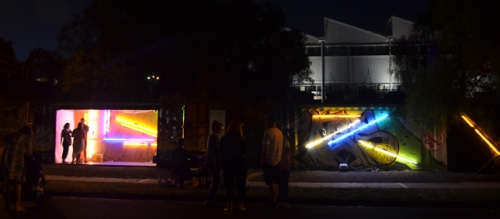
The containers by night. At this point the atmosphere becomes surreal as both real trains and ghost trains pass, and neon glows in the dark.
Listening to the sound recording, which is live and unedited (besides a few cut and pastes to minimize length) gives a sense of the augmented atmosphere. The soundscape, which can be heard below includes the familiar sounds of trucks and trains aside the continuous drones and snores of vibrating containers, and the other-worldly calls of alien industrialism.
The soundcloud link below includes a silhouette of the four artists basking in the nightlight of the neon.
Posted in art, hiddensounds, music | Tagged architecture, atmosphere, intervention, neon, sound design, soundscape, vibration | Leave a Comment »
hiddensounds has emerged (submerged actually) to present a new work thanks to the curators of Liquid Architecture. I’m inhabiting a cavernous underground bunker beneath Federation Square known as the Trench. The Trench was once destined to be a service area for federation square but has since become a haunt for artists intoxicated by its strange presences – sonically and visually. It is a long cuboid concrete room that sits astride platform 13 (the Sandringham line) and houses an intestinal array of piping transporting sewerage cooking oil and other gastronomical delights.
I have entered the space with an eight speaker sound system and have spent time investigating the site to understand its sonic ecology and the extraordinary dynamic range delimited by the blast of train horns at one end and the delicate drippings of concealed pipings at the other. The aim is to create a short lived transformed listening experience for those who descend to the trench with me at the end of the month on Saturday or Sunday.
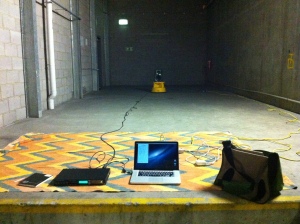
Testing in the Trench
In some ways the work presents a real challenge as the Trench is already a fascinating listening experience. One can spend 20 minutes in the Trench (which is the allocated audience time for the performance) and become intrigued by its unusual sonic ecology in its natural form. But of course I intend to transform this sonic ecology using the method of introducing transformed site specific sounds in the space. Similar to my air-conditioning work Revoicing the Striated Soundscape I hope to create a sonic environment that at once merges the real with the surreal for an altered listening experience, which contrasts the constructed listening experience of a concert.
It would be great if you could make it down and experience Subterranean Voices, a soundwork for the sonic ecology of the Trench. See the Liquid Architecture website for more details, and for the incredible array of interesting works on offer. Liquid Architecture have a facebook page and a Twitter page.
Posted in art, hiddensounds, music | Tagged Federation Square, Liquid Architecture, Sound Art | Leave a Comment »
Yesterday I took my children to Rickett’s Point Marine Sanctuary in Port Phillip Bay and the day before we rambled through the Australian Garden at Cranbourne Royal Botanical Gardens. It is joyful to explore new places with children, particularly your own, and watch them absorbing the wonders of the world. I am reminded of comments by the philosopher Serres:
The world is divine and full of divine things. This sea, this plain, this river, the ice floe, the tree, light and life. I know it, I see it, I feel it, I am illuminated by it, burning… I find happiness in the divinity of things themselves; they push me toward pantheism.
I wonder for how long my children will experience life as joyful: the boundless upsurge of experience. At what point do they/we become weighed down with the exigencies of life? I already see my six your old becoming encumbered with the demands of education. An inevitable downward spiral from an unfettered connection with the divinity of life towards an overladen consciousness that is barred from such direct experience. There are times when I fall into thinking I should be helping my children get ahead of the pack at this early age by schooling them in a musical instrument, problem solving or some other endeavour. And then I think, why? Why these pressures we formulate for ourselves?
Can joy generate knowledge, or is it simply an experience that temporarily surges? What of the Aboriginal people’s of the world, now almost completely colonised, did their knowledge surface thorough joy? Profound knowledge of the medicinal properties of plants and the mythological depths of dreams: I doubt the product of rational processes, but the surging wisdoms of peoples inseparable from the world’s boundless experiential potentials. I’m sure the same ecstasy poured through the veins of our scientists as they attempted to understand the world. But by understanding they crystallised human endeavour in rational forms in which we are now trapped, the immediacy of experiential joy now out of reach. But not so our children, my children, whom seem able to effortlessly dip their hands into the divine pool of the world.
And so any chance I have with my children, we explore! New places, natural places, constructed spaces – crawl inside, get dirty, jump in fright, breath in the scents. Is this the best education, the best start? An education in joy! There is plenty of time for them to become weighed down by civilisation – the demands of education, work, travel, family, politics. And the best part is they remind me to still my own frenetic mind into a quiet certainty, losing myself in the waves, the rolling hills, the clouds; the knowledge that the act of existing is the most wonderful, improbable and fantastic experience of all.
Posted in fatherhood, philosophy, religion, writing | Tagged australian gardens cranbourne, divinity, joy, ricketts point marine sanctuary, Serres | 1 Comment »

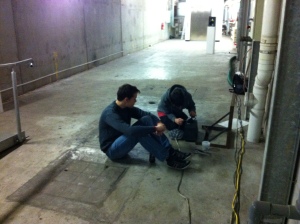


![P14-08-09_14.30[01] P14-08-09_14.30[01]](https://live.staticflickr.com/4039/4366223984_6777a14bf3_s.jpg)
![P11-11-09_14.23[01] P11-11-09_14.23[01]](https://live.staticflickr.com/2510/4366223002_d4c1aee3ef_s.jpg)
